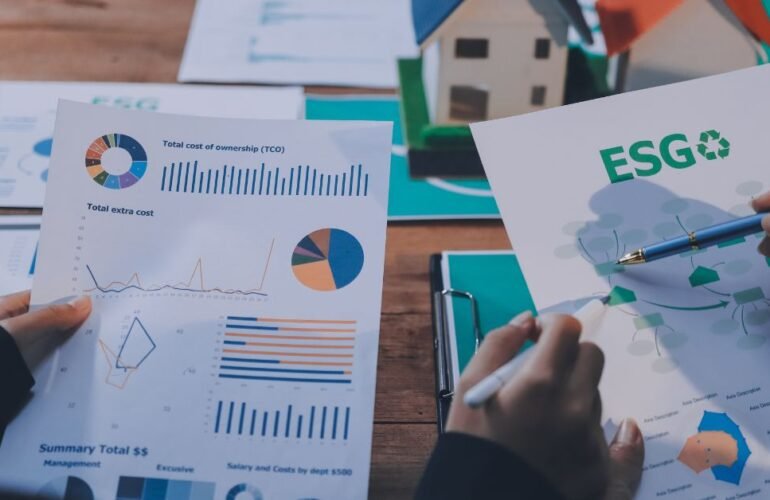How to Design an ESG Report That Actually Gets Read – Designing an ESG report is the final, crucial step in your sustainability journey. You’ve implemented complex ESG initiatives, ensured compliance, and made strides in reducing environmental impacts and uplifting communities. Now, it’s time to communicate all of that—clearly, credibly, and compellingly.
An ESG report is not just a compliance document or a glossy brochure. Done right, it offers stakeholders valuable insights into your sustainability commitments and progress, while also reinforcing your organisation’s reputation, transparency, and long-term vision.
So, how do you go from raw ESG data to a report that informs, engages, and inspires? That’s where ESG report design becomes essential.
What Should Be Included in an ESG Report?

Before diving into layout and visuals, clarity of structure is everything. A well-designed ESG report typically includes several foundational components that serve as anchors for your storytelling—each one a chapter in how your business creates long-term value.
Executive Summary
Provide a high-level overview of your ESG performance, milestones, and commitments. This is often the most read section, so it should be engaging and easy to grasp.
ESG Strategy and Materiality Assessment
Detail how ESG issues are identified and prioritised. Include your engagement process with stakeholders and how it informs your sustainability goals.
KPIs Across Environmental, Social, and Governance Pillars
Present core metrics using both narrative and visuals. Focus on clarity and consistency across reporting periods.
Progress Against Sustainability Goals
Showcase measurable outcomes and whether you’re on track with targets. Highlight both wins and areas for improvement.
Risks, Opportunities, and Outlook
Discuss short- and long-term ESG risks, emerging trends, and how your organisation is positioned to respond.
Framework Alignment
Ensure transparency by aligning with standards like GRI, SASB, or TCFD. Explain your choice of framework and how the report meets its requirements.
Third-Party Assurance
Include any external certifications or audits to reinforce the credibility of your disclosures.
Why ESG Report Design Matters
Sustainability reports are dense with data and nuance. Without thoughtful design, even the most impressive ESG outcomes risk being overlooked. Designing an ESG report is not about decoration—it’s about translating complexity into clarity. A well-designed report enhances accessibility by guiding readers through intuitive layouts and clearly defined sections, making it easy for time-poor stakeholders to find what matters most. It also highlights key metrics through impactful visualisations—graphs, charts, and icons that help readers absorb and interpret data more efficiently. Beyond the data, design brings the human side of ESG to life; incorporating real imagery, concise stories, and tangible examples adds emotional resonance to otherwise technical disclosures. And crucially, high-quality formatting and consistency signal professionalism and credibility, helping position your organisation as transparent, trustworthy, and committed to its sustainability vision.
How to Structure an ESG Report
A well-structured ESG report lays the groundwork for effective design. Before any visual elements are considered, it’s critical to ensure the content flows logically and supports a clear narrative. Structure is what allows your ESG story to be understood—not just scanned. When your data is complex and your audience ranges from investors to regulators to consumers, structure helps create clarity out of potential confusion.
Without a strong structure, even the most beautiful report risks failing its primary purpose: communication. A clear, cohesive structure ensures that your key messages aren’t buried in charts or diluted by inconsistent flow. Instead, they stand out and invite engagement. It’s not just about compliance—it’s about guiding your stakeholders through the value you’re creating and the commitments you’re upholding.
Here’s how to structure your ESG report for maximum impact:
Begin with Why
Set the tone by articulating your ESG vision and the broader business context. What drives your commitment?
Establish Credibility
Describe your stakeholder engagement methods and how they inform your ESG priorities.
Visualise Performance
Use graphics to make complex data more digestible. Highlight trends, benchmarks, and historical comparisons.
Tell Stories, Not Just Statistics
Embed narratives throughout the report to give context to your data. Highlight real-world initiatives and impacts.
Close with Accountability
Summarise your next steps, lessons learned, and commitment to continuous improvement.
What Is the Best Format for ESG Reporting?
Choosing the right format for your ESG report is just as important as the content itself. Format determines how accessible, readable, and ultimately impactful your information will be. A report that is technically sound but difficult to navigate may leave readers disengaged, while a visually coherent and logically formatted document invites exploration and fosters trust. There’s no single right answer, but the best ESG report formats blend usability with structure—ensuring that both data-driven stakeholders and casual readers find value.
Digital-First Formats
Interactive PDFs and microsites are increasingly popular for ESG reporting. They offer flexible navigation, search functionality, and a seamless user experience across devices. For companies targeting global or mobile-first audiences, digital-first formats also enhance accessibility and allow for richer multimedia integration, such as videos or expandable charts.
Modular Structure
A modular approach allows different audiences—investors, employees, regulators, or the public—to locate the sections most relevant to them without reading the entire report. Each module can focus on a specific ESG area or stakeholder concern, making the report more practical and easier to digest.
Brand Consistency
An ESG report is a direct reflection of your corporate identity. Aligning its tone, visuals, and language with your broader brand ensures cohesion across all communication channels. This consistency also signals professionalism and intent, reinforcing stakeholder trust in your ESG commitments.
Design Hierarchy
Design hierarchy refers to the structured arrangement of visual elements to guide the reader’s attention. Effective use of headings, subheadings, typography, colour coding, and spacing helps clarify relationships between sections and emphasises what matters most. It also improves readability and encourages engagement with the content.
Framework Alignment
Finally, your ESG report format should visibly support whichever reporting framework you follow—whether GRI, SASB, TCFD, or others. This alignment not only improves credibility and comparability but also ensures your report meets regulatory or stakeholder expectations. Clear referencing of these frameworks within your design further demonstrates rigour and transparency.
Choosing the Right Visuals and Graphics for Your ESG Report
Visuals are more than just decoration—they are one of the most powerful tools in ESG report design for simplifying complexity and engaging diverse stakeholders. Choosing the right visuals allows you to make ESG data more accessible, while also reinforcing your brand’s credibility and commitment to transparency.
Relevance
Relevance is critical. Rather than relying on generic stock imagery, select visuals that are closely aligned with the subject matter being discussed. This could include photos of your sustainability initiatives, infographics that summarise materiality assessments, or icons representing ESG metrics. Visuals should reflect your organisation’s actual activities and values, not distract from them.
Simplicity
Simplicity also matters. Overly complex graphics or cluttered data visualisations can cause confusion or disengagement. Clean charts and streamlined layouts help your audience absorb information at a glance. Whether you’re showcasing emissions reductions, diversity metrics, or community investments, ensure the visual treatment supports—rather than overwhelms—the content.
Infographics
Infographics are especially effective in ESG report design. By transforming multi-layered data into visually digestible summaries, infographics allow readers to grasp key takeaways without sifting through paragraphs of text. This is particularly useful for performance highlights, timelines, or summaries of stakeholder engagement.
Data visualisation
Data visualisation should be approached with precision. Bar charts, line graphs, and pie charts are frequently used in ESG reporting, but each serves a different purpose. Select the chart type that best represents your data and helps tell the story you want your audience to understand. When done correctly, data visualisation not only clarifies—it persuades.
Reporting Tools and Techniques to Translate Your Data into Design
- Tableau or Power BI to turn raw ESG data into intuitive, engaging visuals.
- Adobe InDesign, Canva, or other professional design tools to bring structure and polish to your report.
- Use brand-aligned, predefined styles and templates to ensure consistency and efficiency, particularly for recurring annual reports.
ESG Report Design: Best Practices
Before we dive into best practices, we’ve also put together a practical guide to make ESG reporting less painful, especially if you’re early in the process or feeling overwhelmed. If that sounds like you, be sure to check out our earlier post: How to Make the ESG Reporting Process Less Painful.
Designing an ESG report requires attention to both detail and the big picture. Here are core principles to apply:
- Prioritise White Space – Don’t overwhelm your reader. Give your content room to breathe so key messages stand out.
- Use Iconography Strategically – Icons can help readers quickly identify sections related to E, S, or G. Use them consistently and sparingly.
- Highlight Goals and Outcomes – Use visual elements to spotlight key accomplishments and progress.
- Readability for Multiple Devices – Many stakeholders will access reports on screens. Use a layout that remains clear and readable across laptops, tablets, and presentation displays.
- Choose Clarity Over Jargon – Avoid acronyms and overly technical language unless it’s essential. Clear writing builds trust.
Designing Your ESG Report with AsiaESG
Designing an ESG report is your opportunity to frame your sustainability efforts as part of a bigger mission—doing business that does good. When structured well and designed with purpose, ESG reports can serve as powerful tools for engagement, reputation-building, and regulatory assurance.
If you’re ready to go even deeper, consider joining our hands-on public workshop: Master the Environmental Section of Your ESG Report – GRI & TCFD Aligned. This class is built to help sustainability professionals and reporting teams align their environmental disclosures with globally recognised frameworks. Drawing from our experience supporting regional listed companies—and as an official GRI and GRESB partner—AsiaESG is making expert ESG knowledge more accessible to those who need it most.
Need help translating complex ESG data into a report that inspires? Talk to our ESG reporting specialists and let’s design a report worth reading. to frame your sustainability efforts as part of a bigger mission—doing business that does good. When structured well and designed with purpose, ESG reports can serve as powerful tools for engagement, reputation-building, and regulatory assurance.
For any enquiries or quotations about ESG Solutions, get in touch with our ESG Solutions department below:




